Effective Microorganisms and Glass Nanopowders from Waste Bottle Inclusion on Early Strength and Microstructure Properties of High-Volume Fly-Ash-Based Concrete
Abstract
1. Introduction
2. Material Design, Proportion, and Methods
2.1. Material Design
2.2. Mix Design Proportions
2.3. Test Setup and Procedures
3. Results, Analysis and Discussion
3.1. Fresh Properties
3.2. Compressive Strength
3.3. Flexural Strength
3.4. Splitting Tensile Strength
3.5. Modulus of Elasticity
3.6. Water Absorption
3.7. Microstructure Analyasis
4. Conclusions
- The workability of prepared concrete is significantly influenced by FA, EM, and WGBNP content. The value of the slump was increased with the replacement of 50%OPC and inclusion of 10% EMs as mixing water replacement, while decreasing with the addition of WGBNPs.
- The strength values were enhanced due to the inclusion of 10% EMs as mixing water replacement and 4 and 6% WGBNPs at early ages.
- The replacement of 50% OPC with FA enhanced the WA value, while the inclusion of 10% EMs as mixing water replacement and 4 and 6% WGBNPs led to a significant decrease in WA (%).
- The incorporation of 10% EMs as mixing water replacement and 4 and 6% of WGBNPs boosted the pozzolanic reaction process, thus increasing the formation of hydrate gels and less unreacted cement/FA.
- The synergy of EMs and WGBNP was found to make the microstructures denser and more homogeneous than the binary mixtures prepared with OPC and FA only, which explained the reason for their higher mechanical performance at early ages.
- Microstructure results (XRD, SEM, EDs, TGA, and DTA) show that the inclusion of EMs and WGBNPs in concrete increased the content of hydration products, leading to high stability and better mechanical performance.
- In short, high-volume FA-based concrete containing local waste materials (glass bottles and effective microorganisms) can be beneficial to achieve sustainable construction materials by reducing landfill problems, saving energy consumption, and lowering the demand for natural resources for concrete production, thus diminishing environmental pollution.
- Although the pH value of effective microorganism solution is lower, which is not a favorable condition for corrosion, effective microorganisms also contain 97.5% rhodium, which has good resistance of corrosion. So, concrete containing effective microorganism solution should be assessed by detailed corrosion investigation.
Author Contributions
Funding
Institutional Review Board Statement
Informed Consent Statement
Data Availability Statement
Acknowledgments
Conflicts of Interest
References
- Huseien, G.; Ismail, M.; Tahir, M.; Mirza, J.; Hussein, A.; Khalid, N.; Sarbini, N. Performance of sustainable alkali activated mortars containing solid waste ceramic powder. Chem. Eng. Trans. 2018, 63, 673–678. [Google Scholar]
- Algaifi, H.A.; Mustafa Mohamed, A.; Alsuhaibani, E.; Shahidan, S.; Alrshoudi, F.; Huseien, G.F.; Bakar, S.A. Optimisation of GBFS, Fly Ash, and Nano-Silica Contents in Alkali-Activated Mortars. Polymers 2021, 13, 2750. [Google Scholar] [CrossRef]
- Li, G.; Zhou, C.; Ahmad, W.; Usanova, K.I.; Karelina, M.; Mohamed, A.M.; Khallaf, R. Fly Ash Application as Supplementary Cementitious Material: A Review. Materials 2022, 15, 2664. [Google Scholar] [CrossRef] [PubMed]
- Reiner, M.; Rens, K. High-volume fly ash concrete: Analysis and application. Pract. Period. Struct. Des. Constr. 2006, 11, 58–64. [Google Scholar] [CrossRef]
- Şahmaran, M.; Li, V.C. Durability properties of micro-cracked ECC containing high volumes fly ash. Cem. Concr. Res. 2009, 39, 1033–1043. [Google Scholar] [CrossRef]
- Uthaman, S.; Vishwakarma, V.; George, R.; Ramachandran, D.; Kumari, K.; Preetha, R.; Premila, M.; Rajaraman, R.; Mudali, U.K.; Amarendra, G. Enhancement of strength and durability of fly ash concrete in seawater environments: Synergistic effect of nanoparticles. Construct. Build. Mater. 2018, 187, 448–459. [Google Scholar] [CrossRef]
- Saha, A.K.; Sarker, P.K. Sustainable use of ferronickel slag fine aggregate and fly ash in structural concrete: Mechanical properties and leaching study. J. Clean. Prod. 2017, 162, 438–448. [Google Scholar] [CrossRef]
- Nath, S.; Kumar, S. Role of particle fineness on engineering properties and microstructure of fly ash derived geopolymer. Construct. Build. Mater. 2020, 233, 117294. [Google Scholar] [CrossRef]
- Hsu, S.; Chi, M.; Huang, R. Effect of fineness and replacement ratio of ground fly ash on properties of blended cement mortar. Construct. Build. Mater. 2018, 176, 250–258. [Google Scholar] [CrossRef]
- Sun, Y.; Wang, K.; Lee, H. Prediction of compressive strength development for blended cement mortar considering fly ash fineness and replacement ratio. Construct. Build. Mater. 2021, 271, 121532. [Google Scholar] [CrossRef]
- Herath, C.; Gunasekara, C.; Law, D.W.; Setunge, S. Performance of high volume fly ash concrete incorporating additives: A systematic literature review. Construct. Build. Mater. 2020, 258, 120606. [Google Scholar] [CrossRef]
- Hemalatha, T.; Ramaswamy, A. A review on fly ash characteristics–Towards promoting high volume utilization in developing sustainable concrete. J. Clean. Prod. 2017, 147, 546–559. [Google Scholar] [CrossRef]
- Huseien, G.F.; Shah, K.W.; Sam, A.R.M. Sustainability of nanomaterials based self-healing concrete: An all-inclusive insight. J. Build. Eng. 2019, 23, 155–171. [Google Scholar] [CrossRef]
- Memon, R.P.; Huseien, G.F.; Saleh, A.T.; Ghoshal, S.K.; Memon, U.; Alwetaishi, M.; Benjeddou, O.; Sam, A.R.M. Microstructure and Strength Properties of Sustainable Concrete Using Effective Microorganisms as a Self-Curing Agent. Sustainability 2022, 14, 10443. [Google Scholar]
- Li, G. Properties of high-volume fly ash concrete incorporating nano-SiO2. Cem. Concr. Res. 2004, 34, 1043–1049. [Google Scholar] [CrossRef]
- Shaikh, F.U.; Supit, S.W. Mechanical and durability properties of high volume fly ash (HVFA) concrete containing calcium carbonate (CaCO3) nanoparticles. Construct. Build. Mater. 2014, 70, 309–321. [Google Scholar] [CrossRef]
- Onaizi, A.M.; Huseien, G.F.; Lim, N.H.A.S.; Amran, M.; Samadi, M. Effect of nanomaterials inclusion on sustainability of cement-based concretes: A comprehensive review. Construct. Build. Mater. 2021, 306, 124850. [Google Scholar] [CrossRef]
- Samadi, M.; Shah, K.W.; Huseien, G.F.; Lim, N. Influence of Glass Silica Waste Nano Powder on the Mechanical and Microstructure Properties of Alkali-Activated Mortars. Nanomaterials 2020, 10, 324. [Google Scholar] [CrossRef]
- Schwarz, N.; Cam, H.; Neithalath, N. Influence of a fine glass powder on the durability characteristics of concrete and its comparison to fly ash. Cem. Concr. Compos. 2008, 30, 486–496. [Google Scholar]
- ASTM C618-22; Standard Specification for Coal Fly Ash and Raw or Calcined Natural Pozzolan for Use in Concrete. ASTM International: West Conshohocken, PA, USA, 2013.
- Khan, M.N.N.; Sarker, P.K. Effect of waste glass fine aggregate on the strength, durability and high temperature resistance of alkali-activated fly ash and GGBFS blended mortar. Construct. Build. Mater. 2020, 263, 120177. [Google Scholar] [CrossRef]
- Harrison, E.; Berenjian, A.; Seifan, M. Recycling of waste glass as aggregate in cement-based materials. Environ. Sci. Ecotechnol. 2020, 4, 100064. [Google Scholar] [CrossRef] [PubMed]
- Khan, M.N.N.; Saha, A.K.; Sarker, P.K. Reuse of waste glass as a supplementary binder and aggregate for sustainable cement-based construction materials: A review. J. Build. Eng. 2020, 28, 101052. [Google Scholar] [CrossRef]
- He, Z.-H.; Zhan, P.-M.; Du, S.-G.; Liu, B.-J.; Yuan, W.-B. Creep behavior of concrete containing glass powder. Compos. Part B Eng. 2019, 166, 13–20. [Google Scholar] [CrossRef]
- Bueno, E.T.; Paris, J.M.; Clavier, K.A.; Spreadbury, C.; Ferraro, C.C.; Townsend, T.G. A review of ground waste glass as a supplementary cementitious material: A focus on alkali-silica reaction. J. Clean. Prod. 2020, 257, 120180. [Google Scholar] [CrossRef]
- Ke, G.; Li, W.; Li, R.; Li, Y.; Wang, G. Mitigation effect of waste glass powders on alkali–silica reaction (ASR) expansion in cementitious composite. Int. J. Concr. Struct. Mater. 2018, 12, 67. [Google Scholar] [CrossRef]
- Zhang, Y.; Xiao, R.; Jiang, X.; Li, W.; Zhu, X.; Huang, B. Effect of particle size and curing temperature on mechanical and microstructural properties of waste glass-slag-based and waste glass-fly ash-based geopolymers. J. Clean. Prod. 2020, 273, 122970. [Google Scholar] [CrossRef]
- Patil, B.H. Utilization of Waste Glass Powder as a Replacement of Cement in Concrete. Int. J. Res. Eng. Sci. Manag. 2020, 3, 466–468. [Google Scholar]
- Arowojolu, O.; Fina, J.; Pruneda, A.; Ibrahim, A.; Mahmoud, E. Feasibility study on concrete performance made by partial replacement of cement with nanoglass powder and fly ash. Int. J. Civ. Eng. 2019, 17, 1007–1014. [Google Scholar] [CrossRef]
- Islam, G.M.S.; Rahman, M.H.; Kazi, N. Waste glass powder as partial replacement of cement for sustainable concrete practice. Int. J. Sustain. Build. Environ. 2017, 6, 37–44. [Google Scholar] [CrossRef]
- Kamali, M.; Ghahremaninezhad, A. Effect of glass powders on the mechanical and durability properties of cementitious materials. Construct. Build. Mater. 2015, 98, 407–416. [Google Scholar] [CrossRef]
- Aliabdo, A.A.; Abd Elmoaty, M.; Aboshama, A.Y. Utilization of waste glass powder in the production of cement and concrete. Construct. Build. Mater. 2016, 124, 866–877. [Google Scholar] [CrossRef]
- He, Z.-H.; Yang, Y.; Zeng, H.; Chang, J.-Y.; Shi, J.-Y.; Liu, B.-J. Waste glass powder and its effect on the fresh and mechanical properties of concrete: A state of the art review. Adv. Concr. Construct. 2020, 10, 417–429. [Google Scholar]
- Jain, K.L.; Sancheti, G.; Gupta, L.K. Durability performance of waste granite and glass powder added concrete. Construct. Build. Mater. 2020, 252, 119075. [Google Scholar] [CrossRef]
- Elaqra, H.; Rustom, R. Effect of using glass powder as cement replacement on rheological and mechanical properties of cement paste. Construct. Build. Mater. 2018, 179, 326–335. [Google Scholar] [CrossRef]
- Deng, Y.; Yan, C.; Zhang, J.; Yin, L.; Liu, S.; Yan, Y. Preparation and mechanical characterization of engineered cementitious composites with high-volume fly ash and waste glass powder. J. Clean. Prod. 2021, 333, 130222. [Google Scholar] [CrossRef]
- Jiang, X.; Xiao, R.; Bai, Y.; Huang, B.; Ma, Y. Influence of waste glass powder as a supplementary cementitious material (SCM) on physical and mechanical properties of cement paste under high temperatures. J. Clean. Prod. 2022, 340, 130778. [Google Scholar] [CrossRef]
- Huseien, G.F.; Hamzah, H.K.; Mohd Sam, A.R.; Khalid, N.H.A.; Shah, K.W.; Deogrescu, D.P.; Mirza, J. Alkali-activated mortars blended with glass bottle waste nano powder: Environmental benefit and sustainability. J. Clean. Prod. 2020, 243, 118636. [Google Scholar] [CrossRef]
- Onaizi, A.M.; Lim, N.H.A.S.; Huseien, G.F.; Amran, M.; Ma, C.K. Effect of the addition of nano glass powder on the compressive strength of high volume fly ash modified concrete. Mater. Today Proceed. 2021, 48, 1789–1795. [Google Scholar] [CrossRef]
- Memon, R.P.; Mohd, A.R.B.; Awang, A.Z.; Huseien, G.F.; Memon, U. A review: Mechanism, materials and properties of self-curing concrete. ARPN J. Eng. Appl. Sci. 2018, 13, 9304–9397. [Google Scholar]
- Nathaniel, O.; Sam, A.R.M.; Lim, N.H.A.S.; Adebisi, O.; Abdulkareem, M. Biogenic approach for concrete durability and sustainability using effective microorganisms: A review. Construct. Build. Mater. 2020, 261, 119664. [Google Scholar] [CrossRef]
- Huseien, G.F.; Sam, A.R.M.; Algaifi, H.A.; Alyousef, R. Development of a sustainable concrete incorporated with effective microorganism and fly Ash: Characteristics and modeling studies. Construct. Build. Mater. 2021, 285, 122899. [Google Scholar] [CrossRef]
- Huseien, G.F.; Joudah, Z.H.; Khalid, N.H.A.; Sam, A.R.M.; Tahir, M.M.; Lim, N.H.A.S.; Alyousef, R.; Mirza, J. Durability performance of modified concrete incorporating fly ash and effective microorganism. Construct. Build. Mater. 2021, 267, 120947. [Google Scholar] [CrossRef]
- Huseien, G.F.; Saleh, A.T.; Ghoshal, S.K. Effective Microorganism Solution and High Volume of Fly Ash Blended Sustainable Bio-Concrete. Biomimetics 2022, 7, 65. [Google Scholar] [CrossRef]
- Huseien, G.F.; Joudah, Z.H.; Memon, R.P.; Sam, A.R.M. Compressive strength and microstructure properties of modified concrete incorporated effective microorganism and fly ash. Mater. Today Proceed. 2021, 46, 2036–2044. [Google Scholar] [CrossRef]
- Ismail, N.; Saman, H.M. Microstructure examination and strength characteristics of effective microbed cement. In Proceedings of the International Conference on Biological, Civil and Environment Engineering, Dubai, United Arab Emirates, 17–18 March 2014; pp. 82–87. [Google Scholar]
- Wang, H.; Li, Q. Prediction of elastic modulus and Poisson’s ratio for unsaturated concrete. Int. J. Solids Struct. 2007, 44, 1370–1379. [Google Scholar] [CrossRef]
- Rashad, A.M.; Ezzat, M. A Preliminary study on the use of magnetic, Zamzam, and sea water as mixing water for alkali-activated slag pastes. Construct. Build. Mater. 2019, 207, 672–678. [Google Scholar] [CrossRef]
- Qin, R.; Hao, H.; Rousakis, T.; Lau, D. Effect of shrinkage reducing admixture on new-to-old concrete interface. Compos. Part B Eng. 2019, 167, 346–355. [Google Scholar] [CrossRef]
- Zuo, W.; Feng, P.; Zhong, P.; Tian, Q.; Gao, N.; Wang, Y.; Yu, C.; Miao, C. Effects of novel polymer-type shrinkage-reducing admixture on early age autogenous deformation of cement pastes. Cem. Concr. Res. 2017, 100, 413–422. [Google Scholar] [CrossRef]
- Zhou, M.; Chen, P.; Chen, X.; Ge, X.; Wang, Y. Study on hydration characteristics of circulating fluidized bed combustion fly ash (CFBCA). Construct. Build. Mater. 2020, 251, 118993. [Google Scholar] [CrossRef]
- ASTM C 150-07; Standard Specification for Portland Cement. ASTM International: West Conshohocken, PA, USA, 2007.
- Standard A C143; Standard Test Method for Slump of Hydraulic-Cement Concrete. ASTM International: West Conshohocken, PA, USA, 2015.
- ASTM A C109/C109M-11; Standard Test Method for Compressive Strength of Hydraulic Cement Mortars. American Society for Testing and Materials International: West Conshohocken, PA, USA, 2011.
- ASTM C 78-02; Standard Test Method for Flexural Strength of Concrete (Using Simple Beam with Third-Point Loading). IACET: Washington, DC, USA, 2002.
- ASTM C496-11; Standard Test Method for Splitting Tensile Strength of Cylindrical Concrete Specimens1. ASTM International: West Conshohocken, PA, USA, 2017.
- Standard A C469/C469M-14; Standard Test Method for Static Modulus of Elasticity and Poisson’s Ratio of Concrete in Compression. ASTM International: West Conshohocken, PA, USA, 2014.
- Hamzah, H.K.; Joudah, Z.H.; Georgescu, D.P.; Khalid, N.H.A.; Huseien, G.F. Laboratory evaluation of alkali-activated mortars modified with nanosilica from glass bottle wastes. Mater. Today Proceed. 2021, 46, 2098–2104. [Google Scholar] [CrossRef]
- Hisseine, O.A.; Tagnit-Hamou, A. Development of ecological strain-hardening cementitious composites incorporating high-volume ground-glass pozzolans. Construct. Build. Mater. 2020, 238, 117740. [Google Scholar] [CrossRef]
- Iqbal, D.M.; Wong, L.S.; Kong, S.Y. Bio-Cementation in Construction Materials: A Review. Materials 2021, 14, 2175. [Google Scholar] [CrossRef] [PubMed]
- Reddy, S.; Rao, M.; Aparna, P.; Sasikala, C. Performance of standard grade bacterial (Bacillus subtilis) concrete. Asian J. Civ. Eng. 2010, 11, 43–55. [Google Scholar]
- Chahal, N.; Siddique, R.; Rajor, A. Influence of bacteria on the compressive strength, water absorption and rapid chloride permeability of fly ash concrete. Construct. Build. Mater. 2012, 28, 351–356. [Google Scholar] [CrossRef]
- Siddique, R.; Chahal, N.K. Effect of ureolytic bacteria on concrete properties. Construct. Build. Mater. 2011, 25, 3791–3801. [Google Scholar] [CrossRef]
- Mohammed, S.; Rahim, N.; Roslan, M. Effect of Effective Microorganisms (EM) on concrete performance. In Proceedings of the IOP Conference Series: Earth and Environmental Science, Changsha, China, 18–20 September 2020; p. 012036. [Google Scholar]
- Chatterjee, A.; Sarkar, A.; Ghosh, S.; Mandal, S.; Chattopadhyay, B. Bacterium-incorporated fly ash geopolymer: A high-performance, thermo-stable cement alternative for future construction material. Clean Technol. Environ. Policy 2019, 21, 1779–1789. [Google Scholar] [CrossRef]
- Abdulkareem, M.; Ayeronfe, F.; Abd Majid, M.Z.; Sam, A.R.M.; Kim, J.-H.J. Evaluation of effects of multi-varied atmospheric curing conditions on compressive strength of bacterial (bacillus subtilis) cement mortar. Construct. Build. Mater. 2019, 218, 1–7. [Google Scholar] [CrossRef]
- Andrew, T.C.S.; Syahrizal, I.I.; Jamaluddin, M.Y. Effective microorganisms for concrete (EMC) admixture–its effects to the mechanical properties of concrete. In Proceedings of the Awam International Conference on Civil Engineering (AICCE’12) Geohazard Information Zonation (GIZ’12), Batu Ferringhi, Malaysia, 28–30 August 2012. [Google Scholar]
- Belie, N. Application of bacteria in concrete: A critical review. RILEM Tech. Lett. 2016, 1, 56–61. [Google Scholar] [CrossRef]
- Achal, V.; Pan, X.; Özyurt, N. Improved strength and durability of fly ash-amended concrete by microbial calcite precipitation. Ecol. Eng. 2011, 37, 554–559. [Google Scholar] [CrossRef]
- Hamzah, N.; Mohd Saman, H.; Baghban, M.H.; Mohd Sam, A.R.; Faridmehr, I.; Muhd Sidek, M.N.; Benjeddou, O.; Huseien, G.F. A Review on the Use of Self-Curing Agents and Its Mechanism in High-Performance Cementitious Materials. Buildings 2022, 12, 152. [Google Scholar] [CrossRef]
- Huseien, G.F.; Faridmehr, I.; Baghban, M.H. Self-Healing Cementitious Materials: Technologies, Evaluation Methods, and Applications; CRC Press: Boca Raton, FL, USA, 2022; Volume 1, pp. 1–39. [Google Scholar]
- Souza, M.T.; Onghero, L.; Correa, B.N.; Selhorst, M.A.; Dias, A.M.; Repette, W.L.; Pereira, F.R.; de Oliveira, A.P.N. Novel low-cost shrinkage-compensating admixture for ordinary Portland cement. Construct. Build. Mater. 2020, 230, 117024. [Google Scholar] [CrossRef]
- Halaweh, M.A. Effect of Alkalis and Sulfate on Portland Cement Systems; University of South Florida: Tampa, FL, USA, 2007; pp. 1–219. [Google Scholar]
- Abd Rahman, N.A.; Sam, A.R.M. Properties of Normal Cement Concrete Containing Effective Microorganism. In Proceedings of the 11th International Civil Engineering Postgraduate Conference—The 1st International Symposium On Expertise of Engineering Design, Tokyo, Japan, 29–31 August 2016; pp. 305–314. [Google Scholar]
- Liu, M.; Tan, H.; He, X. Effects of nano-SiO2 on early strength and microstructure of steam-cured high volume fly ash cement system. Construct. Build. Mater. 2019, 194, 350–359. [Google Scholar] [CrossRef]
- Kamali, M.; Ghahremaninezhad, A. An investigation into the hydration and microstructure of cement pastes modified with glass powders. Construct. Build. Mater. 2016, 112, 915–924. [Google Scholar] [CrossRef]
- Kayali, O.; Ahmed, M.S. Assessment of high volume replacement fly ash concrete–Concept of performance index. Construct. Build. Mater. 2013, 39, 71–76. [Google Scholar] [CrossRef]
- Huang, C.-H.; Lin, S.-K.; Chang, C.-S.; Chen, H.-J. Mix proportions and mechanical properties of concrete containing very high-volume of Class F fly ash. Construct. Build. Mater. 2013, 46, 71–78. [Google Scholar] [CrossRef]
- Yoon, S.; Monteiro, P.J.; Macphee, D.E.; Glasser, F.P.; Imbabi, M.S.-E. Statistical evaluation of the mechanical properties of high-volume class F fly ash concretes. Construct. Build. Mater. 2014, 54, 432–442. [Google Scholar] [CrossRef]
- Duran-Herrera, A.; Juárez, C.; Valdez, P.; Bentz, D.P. Evaluation of sustainable high-volume fly ash concretes. Cem. Concr. Compos. 2011, 33, 39–45. [Google Scholar] [CrossRef]
- Liu, Z.; Chin, C.S.; Xia, J. Improving recycled coarse aggregate (RCA) and recycled coarse aggregate concrete (RCAC) by biological denitrification phenomenon. Construct. Build. Mater. 2021, 301, 124338. [Google Scholar] [CrossRef]
- Reddy, B.M.S.; Revathi, D. An experimental study on effect of Bacillus sphaericus bacteria in crack filling and strength enhancement of concrete. Mater. Today Proceed. 2019, 19, 803–809. [Google Scholar] [CrossRef]
- Jiang, Y.; Ling, T.C.; Mo, K.H.; Shi, C. A critical review of waste glass powder—Multiple roles of utilization in cement-based materials and construction products. J. Environ. Manag. 2019, 242, 440–449. [Google Scholar] [CrossRef]
- Bostanci, L. Effect of waste glass powder addition on properties of alkali-activated silica fume mortars. J. Build. Eng. 2020, 29, 101154. [Google Scholar] [CrossRef]
- Ren, J.; Lai, Y.; Gao, J. Exploring the influence of SiO2 and TiO2 nanoparticles on the mechanical properties of concrete. Construct. Build. Mater. 2018, 175, 277–285. [Google Scholar] [CrossRef]
- Sumesh, M.; Alengaram, U.J.; Jumaat, M.Z.; Mo, K.H.; Alnahhal, M.F. Incorporation of nano-materials in cement composite and geopolymer based paste and mortar—A review. Construct. Build. Mater. 2017, 148, 62–84. [Google Scholar] [CrossRef]
- Patel, D.; Tiwari, R.; Shrivastava, R.; Yadav, R. Effective utilization of waste glass powder as the substitution of cement in making paste and mortar. Construct. Build. Mater. 2019, 199, 406–415. [Google Scholar] [CrossRef]
- Parghi, A.; Alam, M.S. Physical and mechanical properties of cementitious composites containing recycled glass powder (RGP) and styrene butadiene rubber (SBR). Construct. Build. Mater. 2016, 104, 34–43. [Google Scholar] [CrossRef]
- Lam, L.; Wong, Y.; Poon, C.S. Degree of hydration and gel/space ratio of high-volume fly ash/cement systems. Cem. Concr. Res. 2000, 30, 747–756. [Google Scholar] [CrossRef]
- Lothenbach, B.; Scrivener, K.; Hooton, R. Supplementary cementitious materials. Cem. Concr. Res. 2011, 41, 1244–1256. [Google Scholar] [CrossRef]
- Richardson, I. Tobermorite/jennite-and tobermorite/calcium hydroxide-based models for the structure of CSH: Applicability to hardened pastes of tricalcium silicate, β-dicalcium silicate, Portland cement, and blends of Portland cement with blast-furnace slag, metakaolin, or silica fume. Cem. Concr. Res. 2004, 34, 1733–1777. [Google Scholar]
- Deb, P.S.; Sarker, P.K.; Barbhuiya, S. Effects of nano-silica on the strength development of geopolymer cured at room temperature. Construct. Build. Mater. 2015, 101, 675–683. [Google Scholar] [CrossRef]
- Sargam, Y.; Wang, K. Quantifying dispersion of nanosilica in hardened cement matrix using a novel SEM-EDS and image analysis-based methodology. Cem. Concr. Res. 2021, 147, 106524. [Google Scholar] [CrossRef]
- Mhaya, A.M.; Baharom, S.; Huseien, G.F. Improved strength performance of rubberized Concrete: Role of ground blast furnace slag and waste glass bottle nanoparticles amalgamation. Construct. Build. Mater. 2022, 342, 128073. [Google Scholar] [CrossRef]

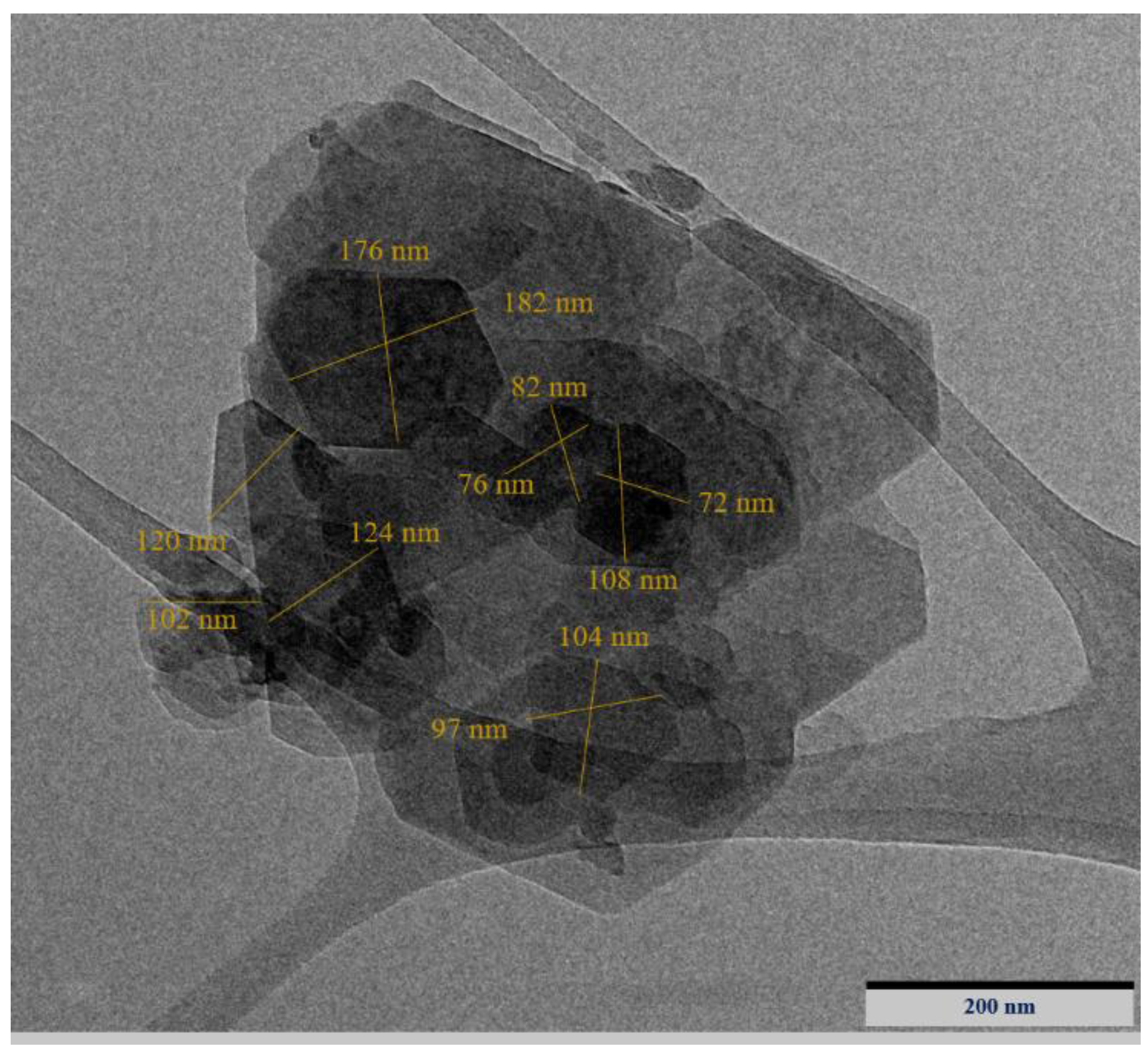
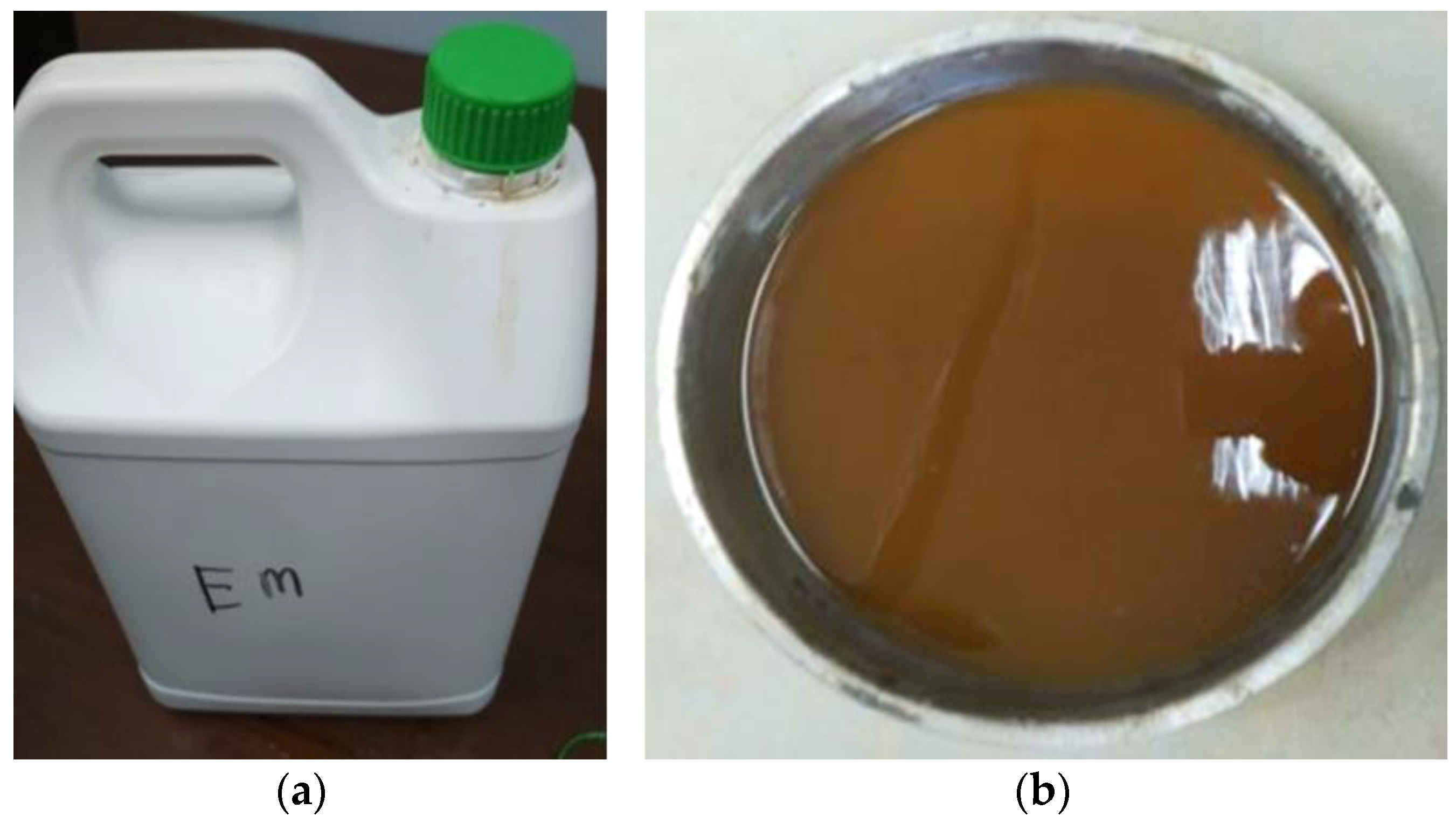
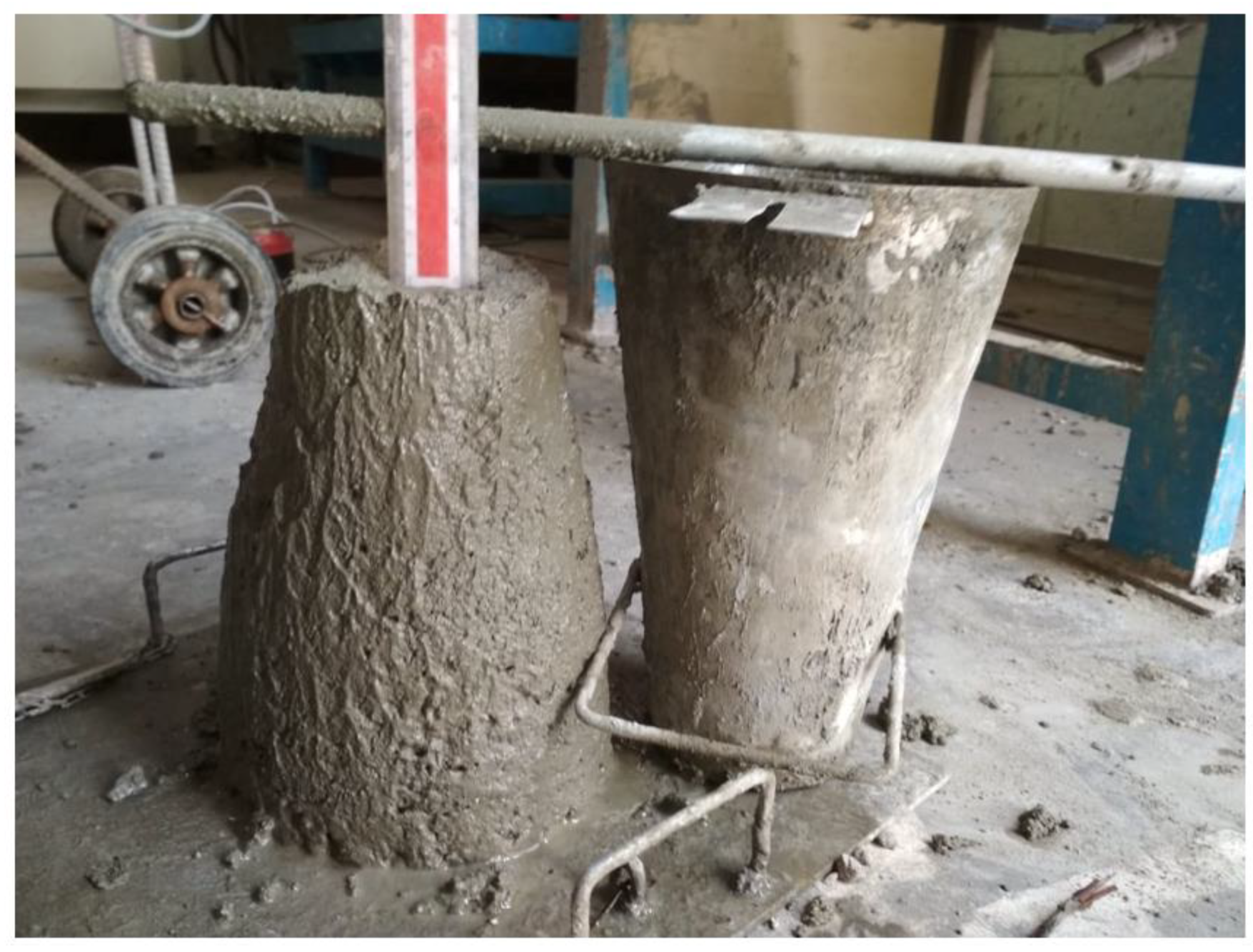

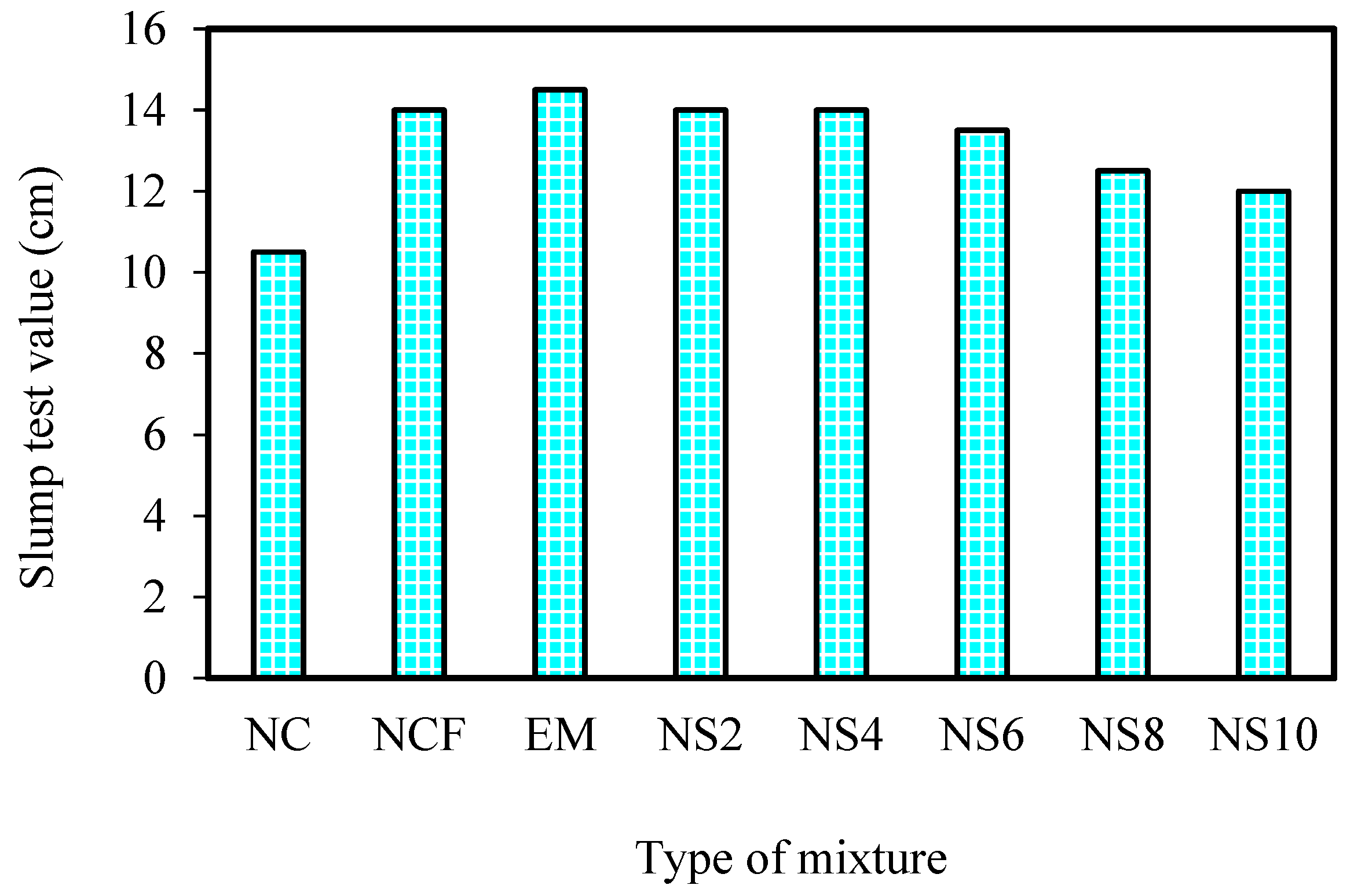
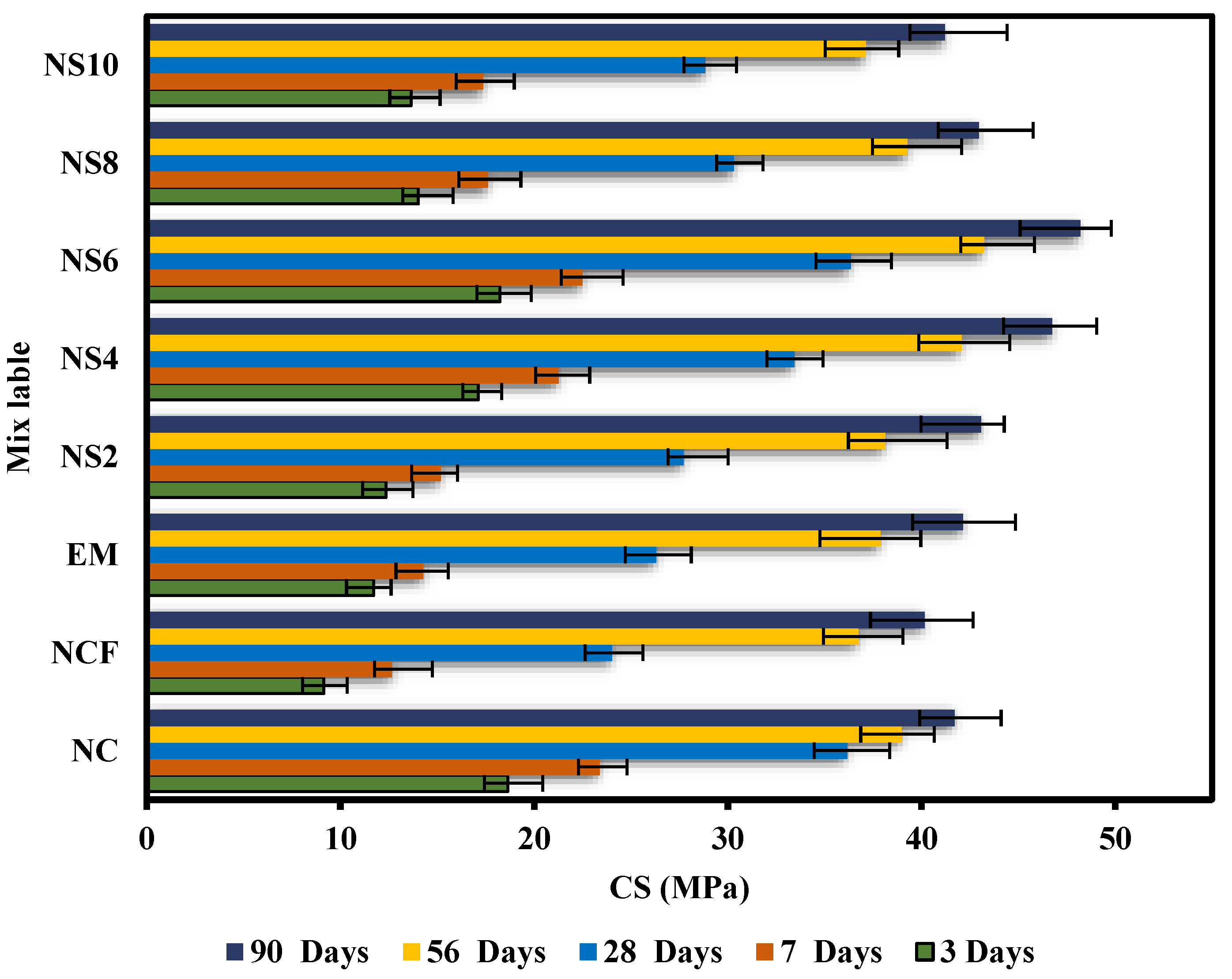
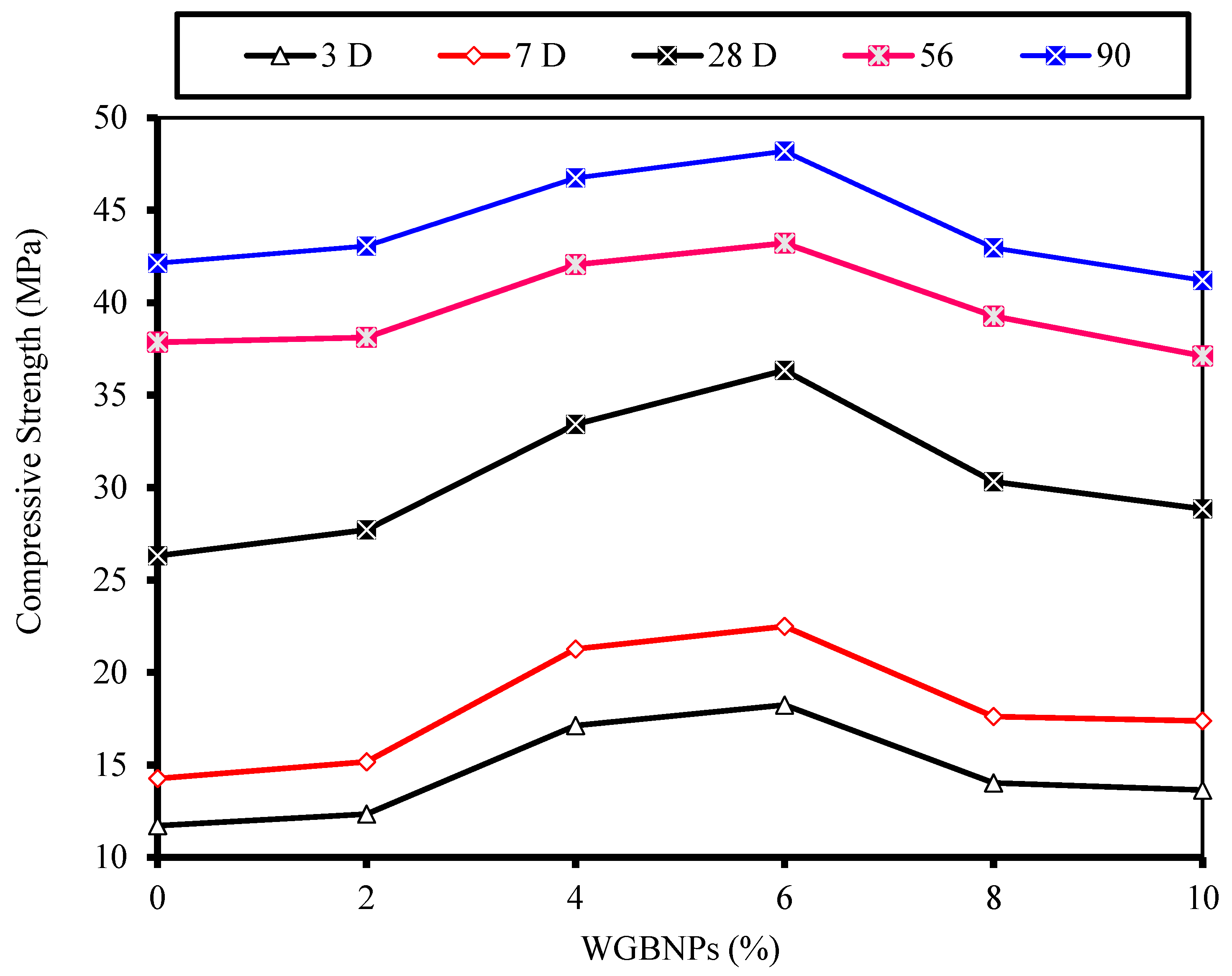
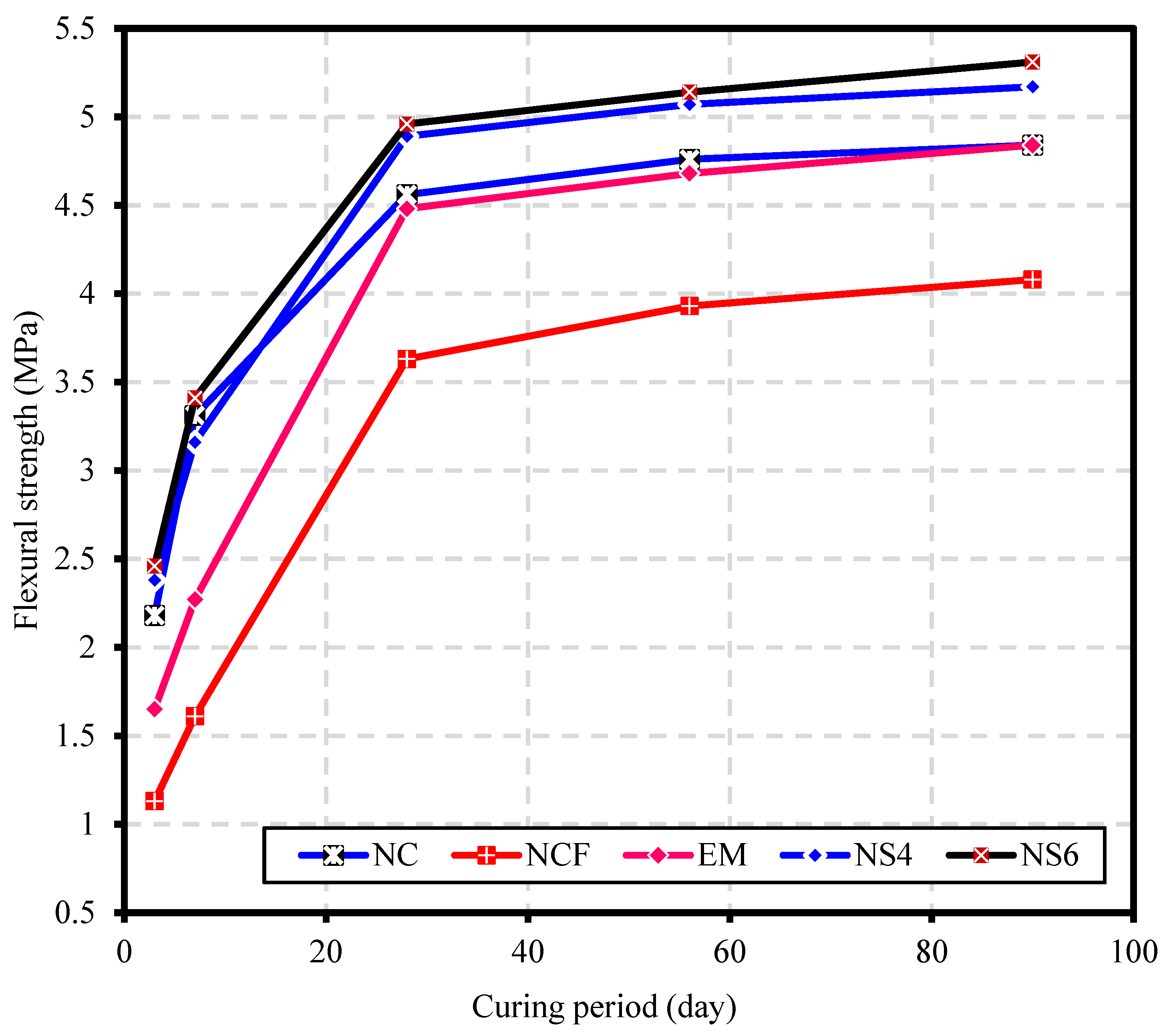
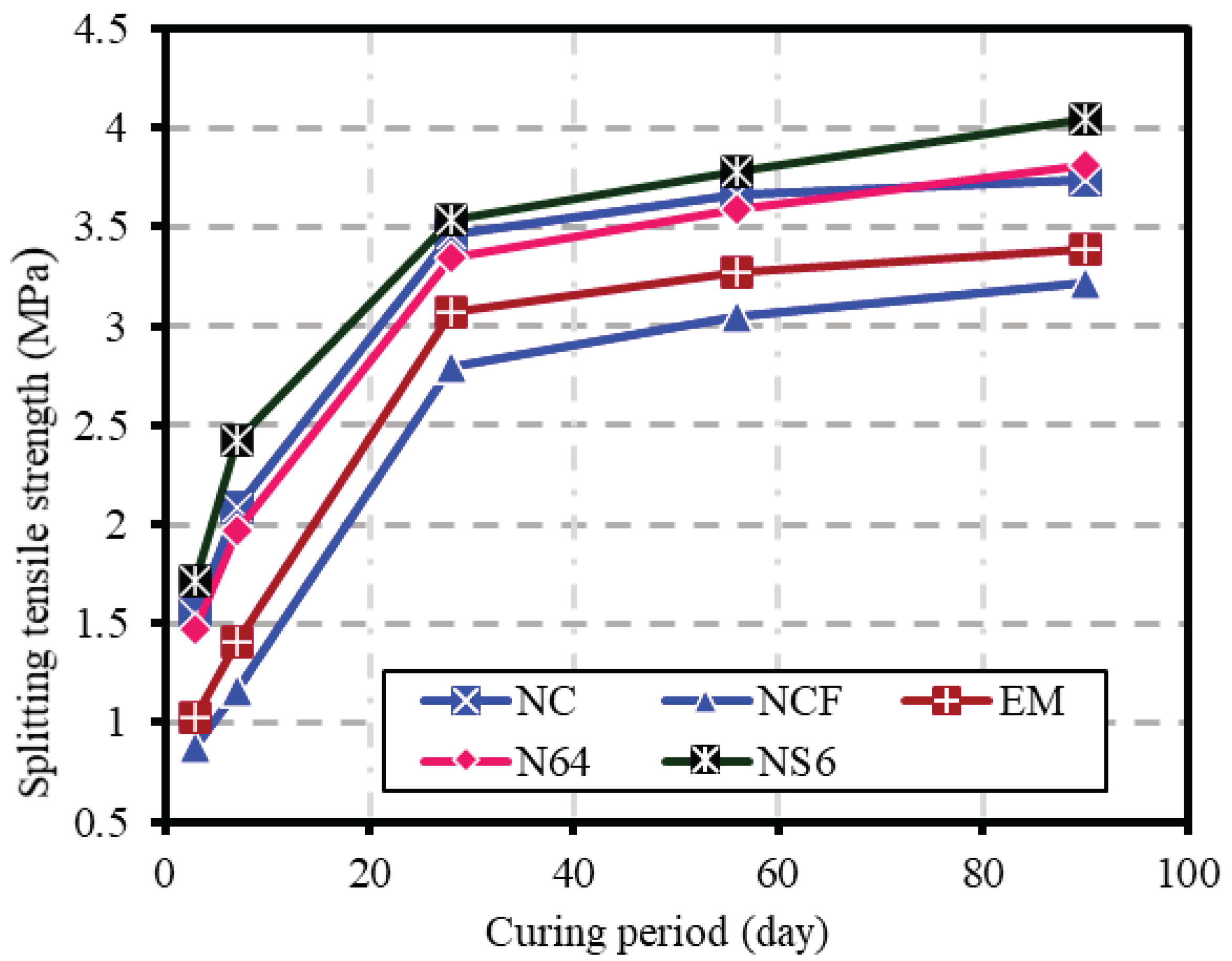

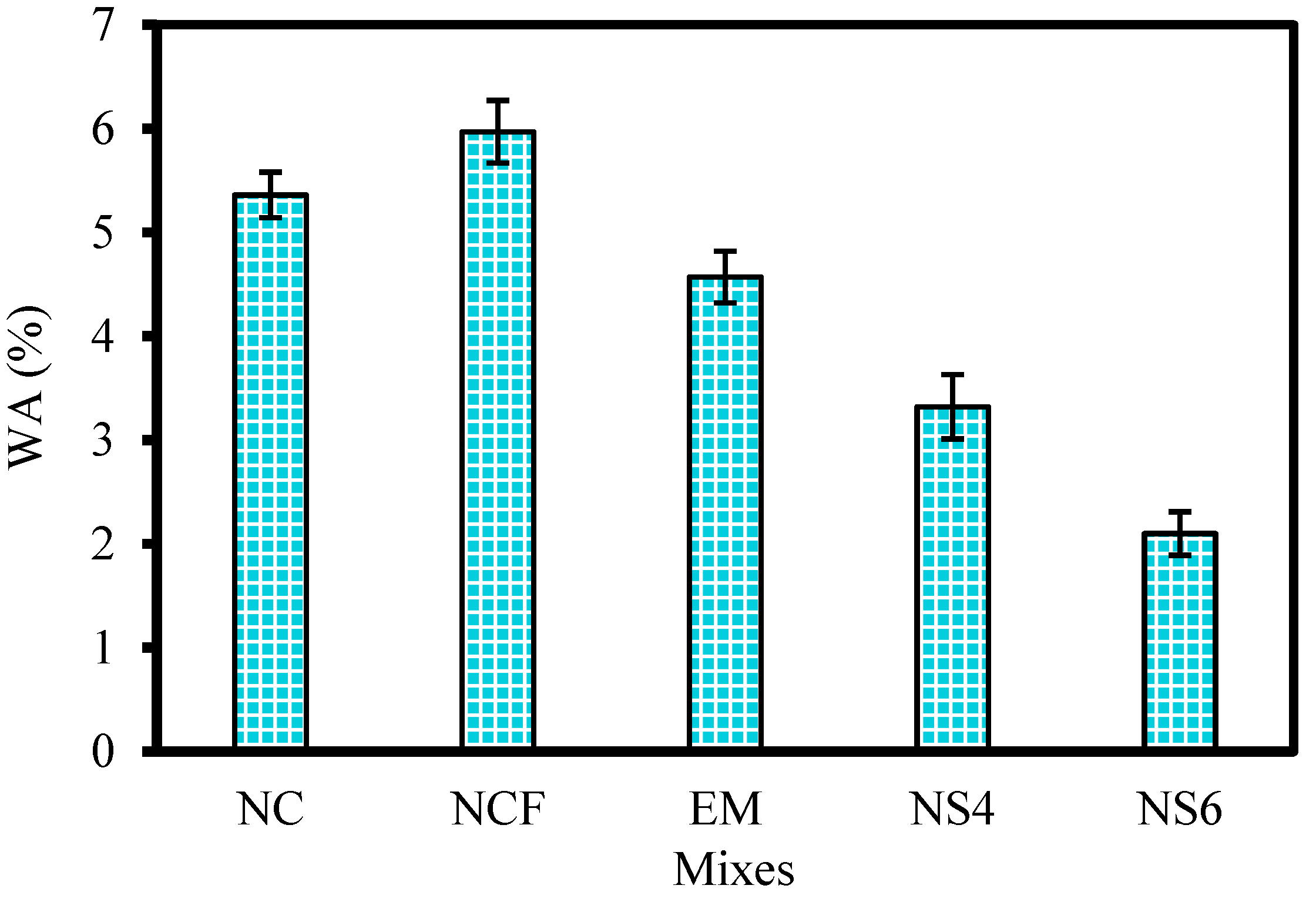
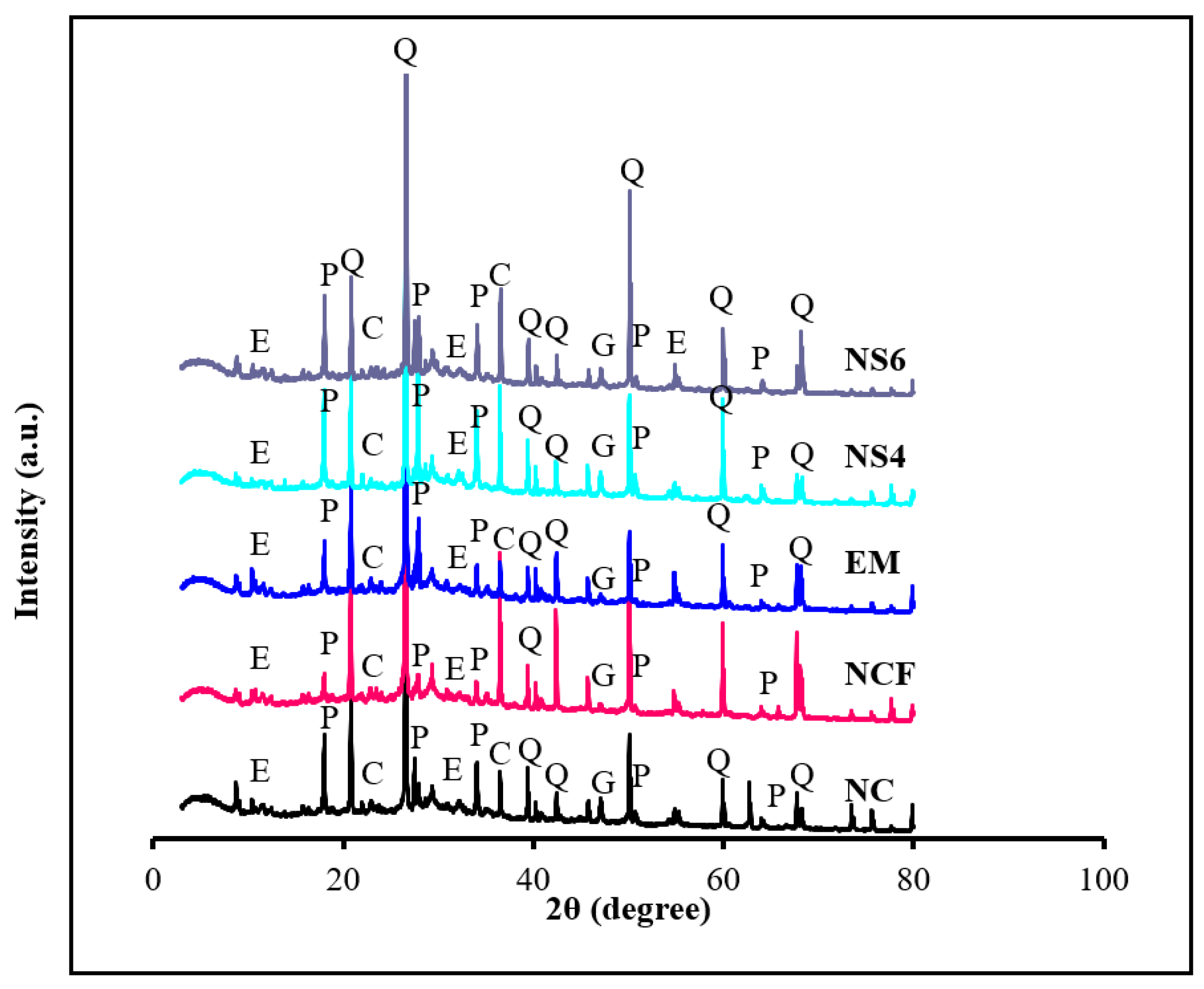
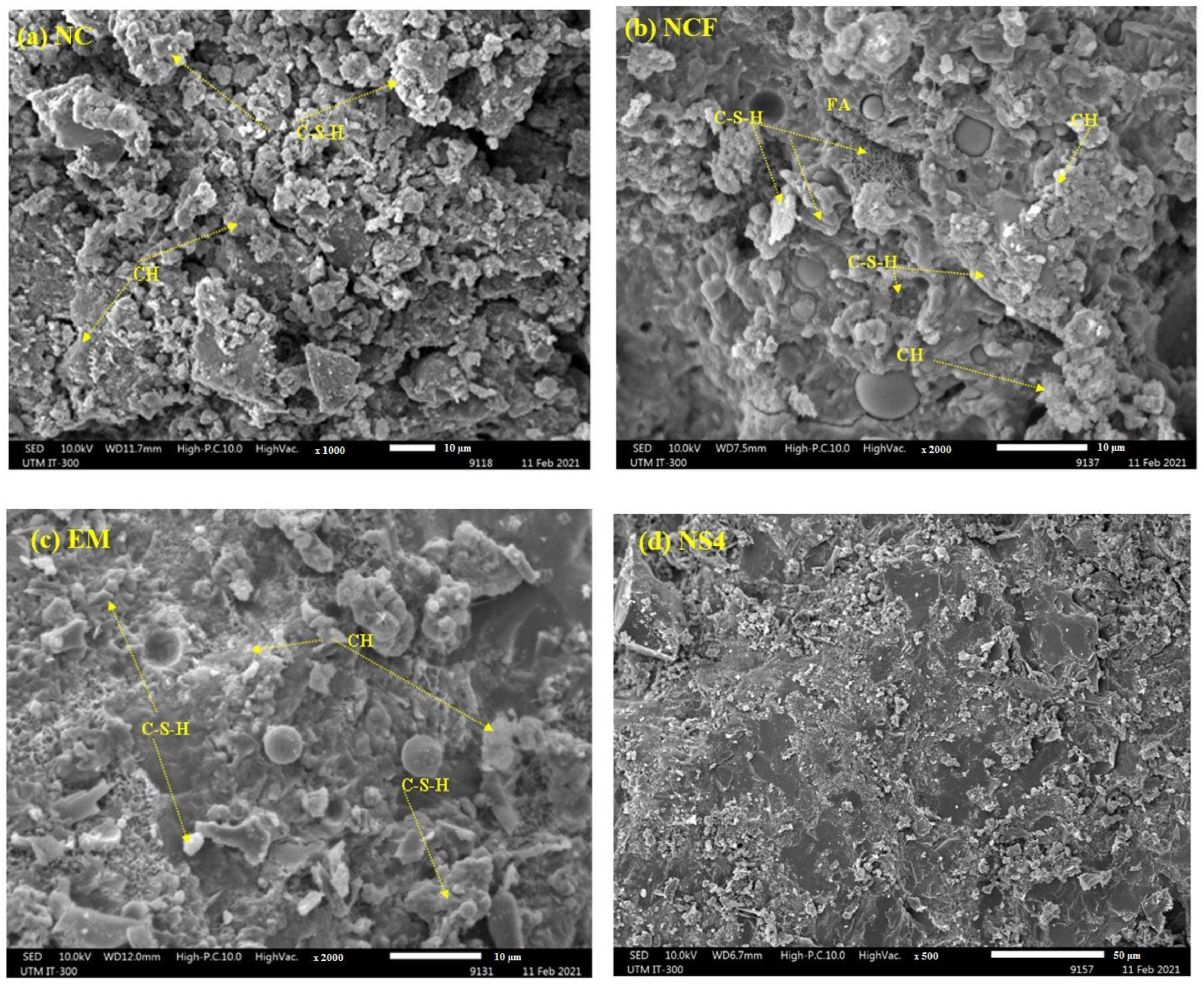


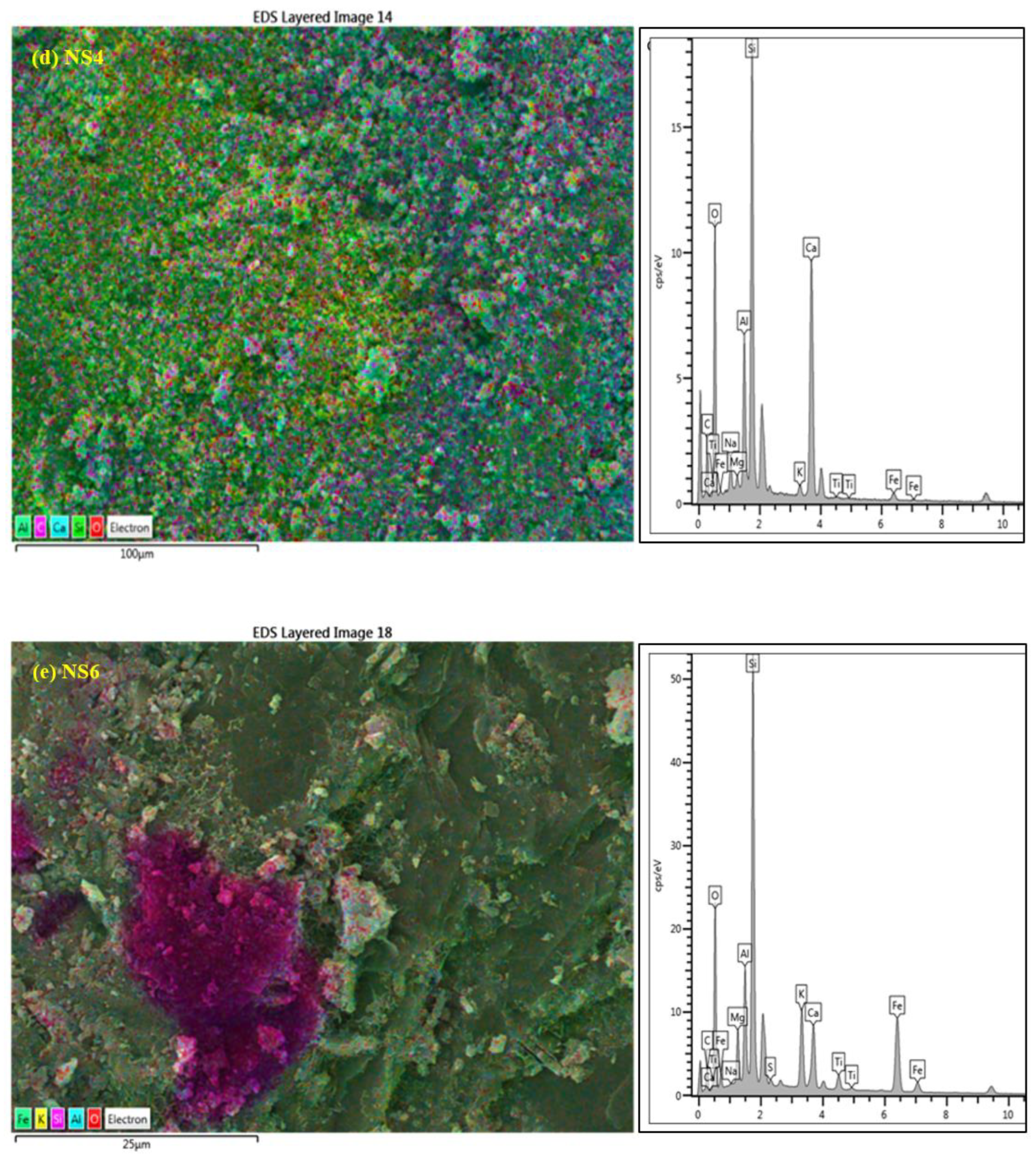

| Elements | Materials | ||
|---|---|---|---|
| OPC | FA | WGBNPs | |
| SiO2 | 17.60 | 57.20 | 69.14 |
| Al2O3 | 4.53 | 28.81 | 13.86 |
| Fe2O3 | 3.35 | 3.67 | 0.24 |
| CaO | 67.84 | 5.16 | 3.16 |
| MgO | 2.18 | 1.48 | 0.68 |
| K2O | 0.27 | 0.94 | 0.01 |
| SO3 | - | 0.10 | 4.08 |
| Na2O | - | 0.08 | 0.01 |
| Loss on ignition, LOI | 1.73 | 0.12 | 0.16 |
| Blaine fineness-BET (cm2/g) | 3995 | - | - |
| Average diameter (µm) | 16.4 | 10 | 0.12 |
| Specific gravity | 3.15 | 2.20 | 1.02 |
| Color | Dark Grey | Grey | Light grey |
| Specific surface area (m2/g) | - | 18.2 | 206 |
| Solution | Viscosity, mPas | pH | Surface Tension, mN/m |
|---|---|---|---|
| Water | 0.95 | 6.7 | 66 |
| EMs | 1.44 | 3.45 | 35.6 |
| 90% water + 10% EMs | 1.05 | 6.3 | 54.5 |
| No. | Mix | Binder (kg/m3) | Solution (kg/m3) | Aggregate (kg/m3) | ||||
|---|---|---|---|---|---|---|---|---|
| OPC | FA | WGBNPs | Water | EMs | Fine | Coarse | ||
| 1 | NC | 460 | 0 | 0 | 230 | 0 | 880 | 820 |
| 2 | NCF | 230 | 230 | 0 | 230 | 0 | 880 | 820 |
| 3 | EM | 230 | 230 | 0 | 207 | 23 | 880 | 820 |
| 4 | NS2 | 230 | 230 | 9.2 | 207 | 23 | 880 | 820 |
| 5 | NS4 | 230 | 230 | 18.4 | 207 | 23 | 880 | 820 |
| 6 | NS6 | 230 | 230 | 27.6 | 207 | 23 | 880 | 820 |
| 7 | NS8 | 230 | 230 | 36.8 | 207 | 23 | 880 | 820 |
| 8 | NS10 | 230 | 230 | 46 | 207 | 23 | 880 | 820 |
| Parameter | NC | NCF | EM | NS4 | NS6 |
|---|---|---|---|---|---|
| C–S–H gel (%) | 16.25 | 9.94 | 13.25 | 14.17 | 14.92 |
| Ca(OH2) (%) | 8.21 | 4.81 | 4.93 | 4.52 | 3.69 |
Publisher’s Note: MDPI stays neutral with regard to jurisdictional claims in published maps and institutional affiliations. |
© 2022 by the authors. Licensee MDPI, Basel, Switzerland. This article is an open access article distributed under the terms and conditions of the Creative Commons Attribution (CC BY) license (https://creativecommons.org/licenses/by/4.0/).
Share and Cite
Onaizi, A.M.; Huseien, G.F.; Shukor Lim, N.H.A.; Tang, W.C.; Alhassan, M.; Samadi, M. Effective Microorganisms and Glass Nanopowders from Waste Bottle Inclusion on Early Strength and Microstructure Properties of High-Volume Fly-Ash-Based Concrete. Biomimetics 2022, 7, 190. https://doi.org/10.3390/biomimetics7040190
Onaizi AM, Huseien GF, Shukor Lim NHA, Tang WC, Alhassan M, Samadi M. Effective Microorganisms and Glass Nanopowders from Waste Bottle Inclusion on Early Strength and Microstructure Properties of High-Volume Fly-Ash-Based Concrete. Biomimetics. 2022; 7(4):190. https://doi.org/10.3390/biomimetics7040190
Chicago/Turabian StyleOnaizi, Ali M., Ghasan Fahim Huseien, Nor Hasanah A. Shukor Lim, W. C. Tang, Mohammad Alhassan, and Mostafa Samadi. 2022. "Effective Microorganisms and Glass Nanopowders from Waste Bottle Inclusion on Early Strength and Microstructure Properties of High-Volume Fly-Ash-Based Concrete" Biomimetics 7, no. 4: 190. https://doi.org/10.3390/biomimetics7040190
APA StyleOnaizi, A. M., Huseien, G. F., Shukor Lim, N. H. A., Tang, W. C., Alhassan, M., & Samadi, M. (2022). Effective Microorganisms and Glass Nanopowders from Waste Bottle Inclusion on Early Strength and Microstructure Properties of High-Volume Fly-Ash-Based Concrete. Biomimetics, 7(4), 190. https://doi.org/10.3390/biomimetics7040190









